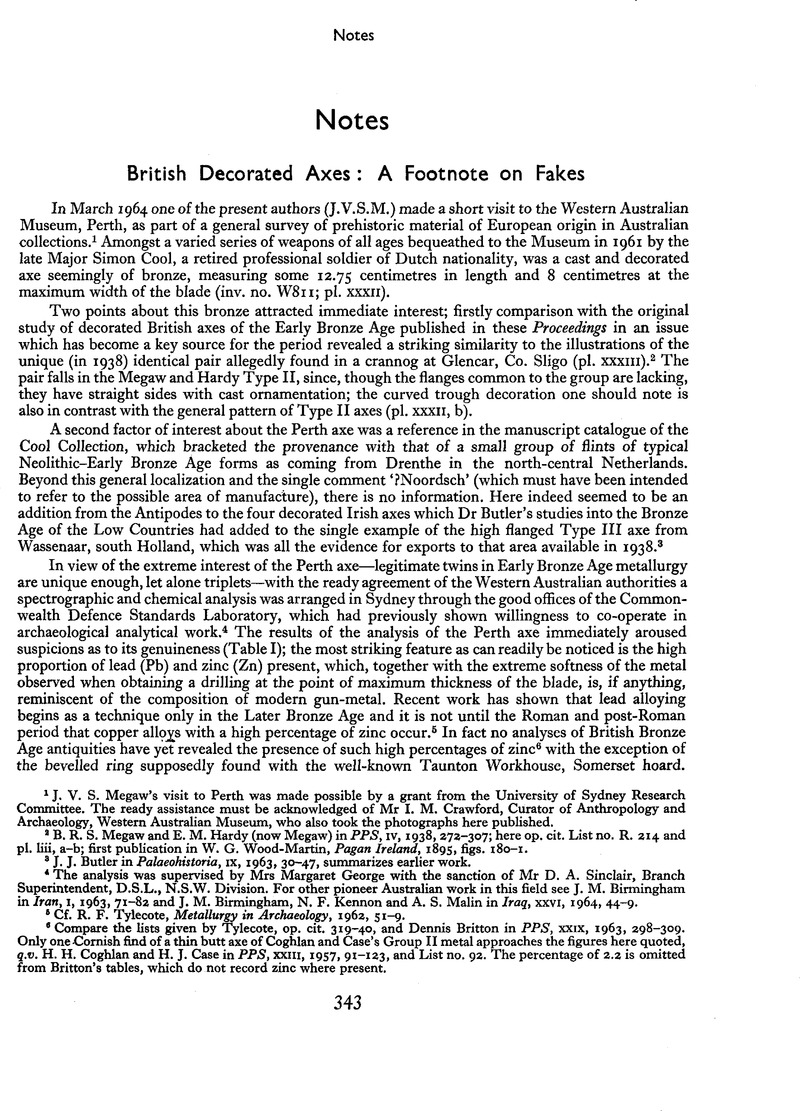No CrossRef data available.
Article contents
British Decorated Axes: A Footnote on Fakes
Published online by Cambridge University Press: 27 May 2014
Abstract

- Type
- Notes
- Information
- Copyright
- Copyright © The Prehistoric Society 1966
References
page 343 note 1 J. V. S. Megaw's visit to Perth was made possible by a grant from the University of Sydney Research Committee. The ready assistance must be acknowledged of Mr I. M. Crawford, Curator of Anthropology and Archaeology, Western Australian Museum, who also took the photographs here published.
page 343 note 2 Megaw, B. R. S. and Hardy, E. M. (now Megaw) in PPS, IV, 1938, 278–307Google Scholar; here op. cit. List no. R. 214 and pl. liii, a–b; first publication in Wood-Martin, W. G., Pagan Ireland, 1895Google Scholar, figs. 180–1.
page 343 note 3 Butler, J. J. in Palaeohistoria, IX, 1963, 30–47Google Scholar, summarizes earlier work.
page 343 note 4 The analysis was supervised by Mrs Margaret George with the sanction of Mr D. A. Sinclair, Branch Superintendent, D.S.L., N.S.W. Division. For other pioneer Australian work in this field see Birmingham, J. M. in Iran, I, 1963, 71–82CrossRefGoogle Scholar and Birmingham, J. M., Kennon, N. F. and Malin, A. S. in Iraq, XXVI, 1964, 44–9CrossRefGoogle Scholar.
page 343 note 5 Cf. Tylecote, R. F., Metallurgy in Archaeology, 1962, 51–9Google Scholar.
page 343 note 6 Compare the lists given by Tylecote, op. cit. 319–40, and Britton, Dennis in PPS, XXIX, 1963, 298–309Google Scholar. Only one Cornish find of a thin butt axe of Coghlan and Case's Group II metal approaches the figures here quoted, q.v. Coghlan, H. H. and Case, H. J. in PPS, XXIII, 1957, 91–123Google Scholar, and List no. 92. The percentage of 2.2 is omitted from Britton's tables, which do not record zinc where present.
page 344 note 1 Brown, M. A. and Blin-Stoyle, A. E. in PPS, XXV, 1959, 208Google Scholar, List no. 471; analysis including 7.5 per cent zinc listed by Blin-Stoyle, in Archaeometry, vol. 2: suppl. 1959, 17Google Scholar. Tylecote, op. cit., 51, presuming the ring to be genuine includes it with other and early objects possibly made from a copper ore of Irish origin with a naturally high percentage of zinc.
page 344 note 2 Miss Audrey Henshall, Assistant Keeper at the National Museum is to be thanked for information and for supplying photographs.
page 344 note 3 Dr I. M. Longworth, Assistant Keeper in the Sub-Department kindly went into the history of the Glencar axes and made the search for their present location.
page 344 note 4 Wood-Martin, op. cit., 424.
page 344 note 5 Garthowen, 4 St. George's Road, Abergele, Denbighshire.
page 345 note 1 Raftery, J. in J.R.S.A.I., 91, 1961, 78Google Scholar, nos. 103–4.
page 346 note 1 See Britton's comments, op. cit., 284–5, on moulds for objects of his ‘Arreton Tradition’ to which group Megaw and Hardy Type II axes belong.
page 346 note 2 Britton, op. cit., 317; Megaw and Hardy, op. cit., List No. R.86.
page 346 note 3 While this note was in the press, the second Glencar axe (1944, 7–2, 2) which had been temporarily mislaid, was relocated and submitted for spectrographic analysis to the British Museum Laboratory which reports as follows: ‘We have now examined the decorated flat axe and compared it … with 1944, 7–2, 1. … The spectra appear to be so closely similar as to suggest that both axes were probably cast from the same batch of metal’.


